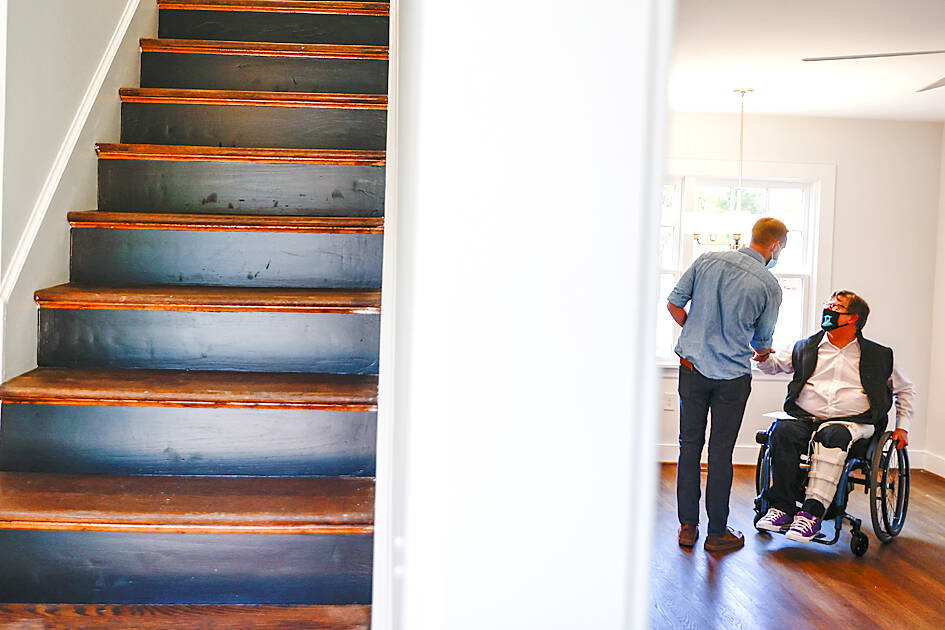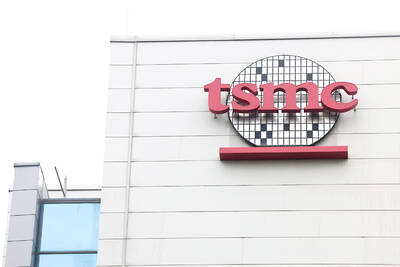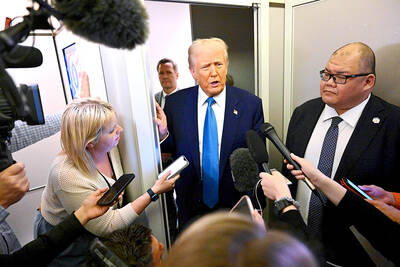Inna and Vladimir Giterman tinkered with several business ideas before finding their niche — and their version of the “American dream” — with crepes.
Both immigrants, and both deaf, the Gitermans started Crepe Crazy in 2007. What began as a mom-and-pop shop at festivals has grown into a full-blown family business with multiple food trucks, two brick-and-mortar restaurants in Texas and a franchise in Baltimore, Maryland.
Everyone who works for the company, including the Gitermans’ two adult children, are either deaf or “deeply involved with the deaf community,” Inna Giterman said in an e-mail.

Photo: AP
Staff communicate using American Sign Language. Customers who cannot sign still order with their hands — by pointing.
Crepe Crazy is one of about 1.8 million businesses in the US that is owned by someone with a disability, according to the American Community Survey conducted by the US Census Bureau (although experts believe that number to be conservative).
While the path to entrepreneurship is rarely easy, business owners with disabilities often need to overcome additional challenges, such as societal misconceptions, barriers to financing, extra living costs and lack of accommodations, among other things.
Entrepreneurs often have to leverage personal savings, credit cards or even a personal loan to fund their business at the outset, but that is complicated for founders with disabilities, especially if they rely on Supplemental Security Income (SSI) and Medicaid, which have income and asset limits, said Nikki Powis, director of small-business programs at the National Disability Institute (NDI).
“A person receiving SSI is only allowed to have US$2,000 in assets,” Powis said. “That makes it very difficult to save money to start a business — and do it yourself — because you can’t have more than US$2,000 in your bank account.”
There are workarounds, including leveraging Achieving a Better Life Experience accounts, tax-free savings and investment accounts that do not count toward the account owner’s asset total.
Business owners should also tap the expertise of a professional to help with benefits planning, Powis said, adding that the NDI can help connect people with those experts.
“Yes, there are barriers and challenges, but you need to find people who are experts that can help you navigate that,” Powis said. “And it should never stop somebody from moving forward with their dreams.”
Securing funding through business loans or venture backing often requires a higher bar for entrepreneurs with disabilities, too. In part because banks, loan officers and investors frequently underestimate what people with a disability are capable of accomplishing.
That stigma can color nearly every business interaction, from winning contracts and customers to leasing commercial real estate.
“I would say probably 99.5 percent of the people that I’ve talked to said they’ve experienced that at some level or other,” Powis said, citing several examples.
These include one business owner who has lost contracts after the other party realized he had a disability, and a female founder who was told by an investor: “Come back to me when you have a male counterpart without a disability.”
Community development financial institutions such as DreamSpring and the Disability Opportunity Fund are working to get business loans to more entrepreneurs with disabilities. Organizations such as 2Gether-International, a start-up incubator for disabled founders, and Communication Service for the Deaf’s Social Venture Fund also offer opportunities for funding, coaching and community with peers.
Diego Mariscal said he sees disability as a strength rather than a weakness for entrepreneurs, which is why he started 2Gether-International to help rewrite the script surrounding people with disabilities.
“Oftentimes, you talk about disability as something that needs to be accommodated or fixed or cured,” said Mariscal, who has cerebral palsy.
In reality, people who live with a disability are resilient as a default — and that’s a “competitive advantage,” he said.
“As disabled people, we have to figure out how do you get dressed, how do you drive, how do you communicate. We have to figure out how to live in a world that is not built to fit our needs,” Mariscal said. “Those skills, those survival skills, can be translated into entrepreneurship skills.”
The Gitermans are changing the narrative, too, one customer at a time. While customers come to their food trucks and restaurants for tasty crepes, they also get a glimpse at a thriving business run almost entirely by deaf people. This leaves an impression.
“We appreciate that they come in for food because they know it’s uniquely good,” Inna Giterman said. However, “it is more satisfying knowing that they leave with more than just a happy stomach.”
This article was provided to The Associated Press by the personal finance Web site NerdWallet.

When an apartment comes up for rent in Germany’s big cities, hundreds of prospective tenants often queue down the street to view it, but the acute shortage of affordable housing is getting scant attention ahead of today’s snap general election. “Housing is one of the main problems for people, but nobody talks about it, nobody takes it seriously,” said Andreas Ibel, president of Build Europe, an association representing housing developers. Migration and the sluggish economy top the list of voters’ concerns, but analysts say housing policy fails to break through as returns on investment take time to register, making the

‘SILVER LINING’: Although the news caused TSMC to fall on the local market, an analyst said that as tariffs are not set to go into effect until April, there is still time for negotiations US President Donald Trump on Tuesday said that he would likely impose tariffs on semiconductor, automobile and pharmaceutical imports of about 25 percent, with an announcement coming as soon as April 2 in a move that would represent a dramatic widening of the US leader’s trade war. “I probably will tell you that on April 2, but it’ll be in the neighborhood of 25 percent,” Trump told reporters at his Mar-a-Lago club when asked about his plan for auto tariffs. Asked about similar levies on pharmaceutical drugs and semiconductors, the president said that “it’ll be 25 percent and higher, and it’ll

NOT TO WORRY: Some people are concerned funds might continue moving out of the country, but the central bank said financial account outflows are not unusual in Taiwan Taiwan’s outbound investments hit a new high last year due to investments made by contract chipmaker Taiwan Semiconductor Manufacturing Co (TSMC, 台積電) and other major manufacturers to boost global expansion, the central bank said on Thursday. The net increase in outbound investments last year reached a record US$21.05 billion, while the net increase in outbound investments by Taiwanese residents reached a record US$31.98 billion, central bank data showed. Chen Fei-wen (陳斐紋), deputy director of the central bank’s Department of Economic Research, said the increase was largely due to TSMC’s efforts to expand production in the US and Japan. Investments by Vanguard International

WARNING SHOT: The US president has threatened to impose 25 percent tariffs on all imported vehicles, and similar or higher duties on pharmaceuticals and semiconductors US President Donald Trump on Wednesday suggested that a trade deal with China was “possible” — a key target in the US leader’s tariffs policy. The US in 2020 had already agreed to “a great trade deal with China” and a new deal was “possible,” Trump said. Trump said he expected Chinese President Xi Jinping (習近平) to visit the US, without giving a timeline for his trip. Trump also said that he was talking to China about TikTok, as the US seeks to broker a sale of the popular app owned by Chinese firm ByteDance Ltd (字節跳動). Trump last week said that he had